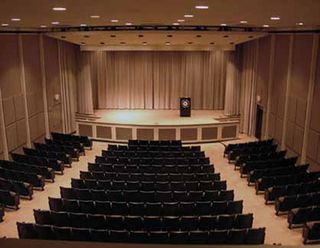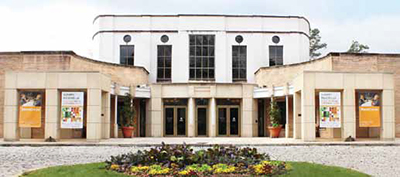Founded in 1926, the Atlanta History Center connects with 228,000 visitors every year.The Atlanta History Center (AHC), which was founded in 1926, is in a period of tremendous growth. Its mission to link people, history, and culture through innovative programming connects with 228,000 visitors, including 60,000 school children, every year. In order to accommodate an expanding membership, increasing visitor base, and a broadening range of programs, AHC increasingly relied on the 400-seat Woodruff Auditorium that was constructed in 1975. Although minor upgrades to the audiovisual system had taken place over the years, the facility was still using some of the original 1970s vintage equipment—components that were themselves becoming historical artifacts.
“In today’s constantly evolving world of technology, we must be able to connect our visitors with history through a variety of methods, not just traditional exhibitions and displays,” said Hillary Hardwick, vice president of marketing communications with AHC. “We must adapt our methods to meet the current and future needs of our diverse and growing audience, and having the right technology plays a significant role in how we deliver innovative programming.”
AHC consulted with Rogers Dixson, president and owner of Atlanta’s Cape Dixson Associates Incorporated (CDAI). In addition to having worked on a number of exhibits and new facilities over the years, CDAI had consulted on a significant renovation to the Woodruff Auditorium’s acoustics a number of years before.
CDAI realized that, while modern technologies existed that would meet AHC’s needs, the budget posed several challenges to the project team. CDAI proposed that AHC consider a different approach for the project. CDAI brought in Sound Design & Innovation (SDI), a new audiovisual system integration company started by Aaron Catlin, a former CDAI employee.
A number of outstanding products were considered for the project but all of the original options posed challenges for the tight budget. Ultimately, the team decided on Symetrix’s Radius 12x8 Dante network audio DSP as the best “fit” for the project. The key element of the Symetrix system is Dante audio networking protocol, for which SDI wired the facility with Cat-6 cabling.

Atlanta’s Cape Dixson Associates Incorporated decided on Symetrix’s Radius 12x8 Dante network audio DSP to upgrade the auditorium.“The Symetrix Radius 12x8 has a powerful open-architecture DSP. It is fully and reliably controllable from a third-party application and its I/O is flexible and expandable for the future via the Dante network. In this installation it’s handling all of the processing for the main auditorium and the two overflow rooms, including room combining, but we’re only using about twenty percent of its DSP horsepower. Because the whole place is now wired with Cat-6, AHC can easily expand or bring in additional Dante-compatible equipment for larger events,” said Catlin.
Bose digital amplifiers power a pair of discrete three-element Bose column arrays and subwoofers that, in combination with the CDAI-designed acoustical environment, provide an amazing sound quality improvement in the space.
Six new Shure ULX-D series wireless microphones provide the workhorse, day-in-day-out inputs to the system. “Because AHC is in the Buckhead area of Atlanta—an area that can be an RF interference nightmare—I was glad to have Shure’s new Dante-based system to provide a reliable front end,” said Catlin. Outputs from video players, microphones from two overflow event rooms, and a stage box comprise the remaining inputs to the system. Since they interface seamlessly into a Dante network, the Shure system is fully available for processing and matrixing within the Symetrix Radius 12x8 DSP and doesn’t use any of its twelve physical inputs.
A Key Digital Compass Control system provides iPad and iPod-based touch control of every aspect of the room’s functionality. It controls a new Digital Projection E-Vision 8,000 lumen video projector, new DMX controlled stage lighting, the existing stage curtains, the projection screen, and a variety of music and video playback devices. It also integrates with the Symetrix SymNet Radius 12x8 DSP to control room combining, input selection, volume, and other relevant system controls.











